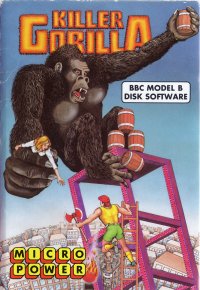| Killer Gorilla | |
|---|---|
 | |
| Publisher | Micro Power |
| Designer | Adrian Stephens [1] |
| Platforms | BBC Micro, Acorn Electron, Amstrad CPC |
| Release | 1983 |
| Genre | Platform |
| Mode | Single-player |
Killer Gorilla is a Donkey Kong clone written by Adrian Stephens and published by Micro Power for the BBC Micro in 1983. [1] It was ported to the Acorn Electron and Amstrad CPC computers in 1984.
Contents
Stephens wrote Killer Gorilla at the age of 17 after buying a magazine with screenshots of Donkey Kong . [2] He was paid 400 pounds for the game. [3] Stephens wrote two other games for Micro Power: Escape From Moonbase Alpha and Mr EE, a clone of Universal's Mr. Do! . [1]
